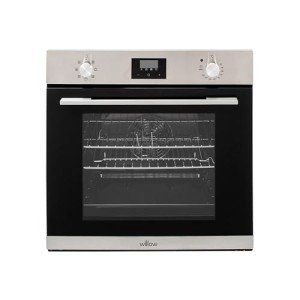10 Fundamentals To Know Integrated Oven Sizes You Didn't Learn In The Classroom

Understanding Integrated Oven Sizes: A Comprehensive Guide
Integrated ovens have actually ended up being synonymous with contemporary kitchens, offering streamlined aesthetics and efficient cooking options. As property owners goal for a smooth look in their cooking spaces, understanding integrated oven sizes ends up being crucial for enhancing kitchen designs and ensuring effective cooking. This post looks into the various integrated oven sizes available in the market, their measurements, and how to choose the best one for your home.
What is an Integrated Oven?
An integrated oven is created to be built into kitchen cabinets, supplying a streamlined appearance that mixes effortlessly with the remainder of the kitchen. Unlike freestanding designs, integrated ovens can be hidden behind kitchen cabinetry doors or positioned at eye level, making them a popular choice for modern kitchen areas.
Key Features of Integrated Ovens
- Space-saving style: Optimizes kitchen area without jeopardizing design.
- Adjustable finishes: Available in numerous colors and products to match kitchen design.
- Advanced technology: Often geared up with modern-day functions, consisting of clever innovation, varying cooking modes, and energy-efficient operations.
Typical Integrated Oven Sizes
When considering an integrated oven, the most crucial aspect to examine is its size. Integrated ovens are available in various measurements, normally created to fit standard kitchen cabinets. The following table lays out the most common integrated oven sizes:
| Oven Type | Height (mm) | Width (mm) | Depth (mm) | Cooking Capacity (litres) |
|---|---|---|---|---|
| Single Built-In | 590 | 595 | 550 | 60-70 |
| Double Built-In | 590 | 595 | 550 | 60 (each oven, overall 120) |
| Compact Built-In | 450 | 595 | 550 | 30-40 |
| Combination Microwave | 455 | 595 | 550 | 30-40 |
| Wall Oven | 720 | 600 | 550 | 70-90 |
Factors to consider When Choosing an Integrated Oven Size
When it concerns picking the appropriate size for an integrated oven, there are several elements to think about:
- Kitchen Layout: Evaluate your kitchen space and choose where the oven will be integrated into kitchen cabinetry.
- Cooking Needs: Consider how typically you prepare and your cooking preferences (e.g., baking, roasting).
- Offered Space: Measure readily available kitchen cabinetry dimensions to ensure the oven fits comfortably.
- Capacity Requirements: Assess the size of meals you generally prepare, especially for families or when entertaining guests.
- Future-proofing: Think about incorporating patterns such as smart innovation or flexibility in use.
Kinds Of Integrated Ovens
Integrated ovens are offered in several types, each offering distinct benefits:
- Conventional Ovens: Standard cooking functions, ideal for a lot of cooking techniques like baking and roasting.
- Steam Ovens: Utilize steam for cooking, perfect for healthier meals, maintaining moisture and nutrients.
- Convection Ovens: Circulate hot air for even cooking, excellent for baking pastries and multiple meals at the same time.
- Microwave Ovens: Offer fast reheating or defrosting choices and can be combined with standard ovens for adaptability.
Advantages of Integrated Ovens
Integrated ovens supply various benefits that can enhance the cooking experience:
- Aesthetics: Offers a tidy style that fits flawlessly into any kitchen design.
- Space effectiveness: Maximizes space by utilizing built-in cabinets.
- Ergonomics: Mounting ovens at eye level enhances benefit and security when getting rid of hot meals.
- Increased performance: Many integrated choices feature features such as self-cleaning and smart connection.
Often Asked Questions (FAQs)
1. What is the standard size for an integrated oven?
The most common size for a single built-in oven is roughly 590mm in height, 595mm in width, and 550mm in depth.
2. Can I set up an integrated oven in an existing kitchen?
Yes, as long as the existing cabinets can accommodate the size and specs of the picked oven, it can be integrated effortlessly.
3. Do integrated ovens have a bigger capability than freestanding ones?
Usually, integrated ovens have a comparable capacity to freestanding models; nevertheless, particular designs may differ. Constantly examine the specs for optimal space and capability.
4. Are integrated ovens more expensive than freestanding ovens?
Integrating an oven can be more pricey due to setup and customization. However, prices vary based on brand name and innovation, so it's important to compare options.
5. Is maintenance various for integrated ovens?
Maintenance for integrated ovens is comparable to that of freestanding models but may need more care with built-in kitchen cabinetry elements. Routine cleaning and comprehending the oven's features are vital for durability.
Choosing the right integrated oven size is vital for optimizing kitchen area and enhancing cooking experiences. By understanding the different configurations available and considering individual cooking requirements, property owners can seamlessly integrate a modern-day oven into their kitchen areas. With Full Document of styles to match diverse aesthetic appeals and functionalities, integrated ovens remain a popular choice for modern cooking areas. Whether you're renovating or building a brand-new kitchen, picking an integrated oven customized to your needs will ensure years of satisfaction and culinary imagination.

